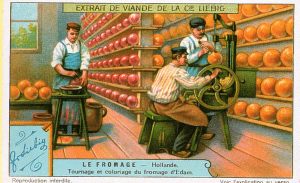A note on some cheeses… from New Jersey
In our lucky era of artisanal cheesemakers, it is easy to forget the ugly history of cheese production in the United States. American agribusiness is guilty of creating ‘Limburger,’ Velveeta and, of course, American cheese or, more accurately, ‘processed American cheese food slices,’ for they always come sliced and are too adulterated to qualify for the liberal FDA definition of cheese itself.
When thoughtful shoppers think of cheese in America, they usually think of Hudson Valley New York and Vermont, Iowa for Maytag blue, goat people it seems everywhere and sometimes Wisconsin which, however, cranks out a lot of inferior factory production. When thoughtful shoppers think of New Jersey, however, they think tomatoes if the state is lucky or oil refineries if it is not.
The Editor has been maligned as contrarian in certain circles, and here she goes again, inviting ridicule. The best of many good cheeses made in the United States at this writing are made in New Jersey, by Valley Shepherd Creamery or, in the argot of the internet, njCheese.com. Unlike, for example, Cabot in Vermont (which does, however, produce some good sharp Cheddars), Valley Shepherd is not a cooperative that blends its milk from different flocks, herds and whatever one calls groups of goats. Instead, Valley Shepherd keeps some seven hundred head of those sheep, cows and goats, and makes cheese exclusively from its own animals.

That cheese, without hyperbole, is peerless. The problem with blended cheese like Cabot is the relatively bland and even indistinct flavor of every variant from mild to extra sharp. Each Valley Shepherd product, however, is so distinctive a creature of its locality that the chart of analogous European cheeses the dairy understandably uses to guide its customers does not really do justice to the high quality of any one of them. All of the varieties that our panel at britishfoodinamerica has tasted have been superlative, including Nettlesome (‘resembles Gouda with nettles’), Perlitta (‘Mimolette’), Shepherd’s Basket (‘Manchego’), Somerset (‘Comte’) and Valley Thunder (‘Cloth bound cheddar [sic]’).
It is the Thunder that packs the biggest impact for our immediate purpose, for it is the only American Cheddar we have found that has the texture of the English paradigm. Other American versions cross a textural spectrum from rubber to heavy cream, with the exception of the longest aged sharpies from Grafton in Vermont. That cheese, while creamy too, also can embody hints of the firmer, flakier mass that makes the best English Cheddars, Montgomery for example, so beguiling. Valley Thunder goes further, and has that English texture. It also bursts with terroir (awful term, we know, but succinct) and tastes very much of itself and nothing else. This is a sharp cheese that shares precisely the bite of what the British call ‘mature’ Cheddar. No American analogue approaches this one in complexity or sheer quality.
Again, however, to describe it as ‘like’ Montgomery or another unique English ‘farmhouse’ Cheddar would not be fair to the New Jersey cheese. This cheese is unlike anything else.
Valley Shepherd cheeses are relatively hard to find and worth seeking out. The producer has shops at its creamery in Long Valley, New Jersey and at 79 Sullivan Street in Manhattan. They usually pitch stalls at a number of farmers’ markets in the metropolitan New York region, including markets at both Bowling Green and Union Square in the city, and behind Nassau Hall on the campus of Princeton University. Find some.

